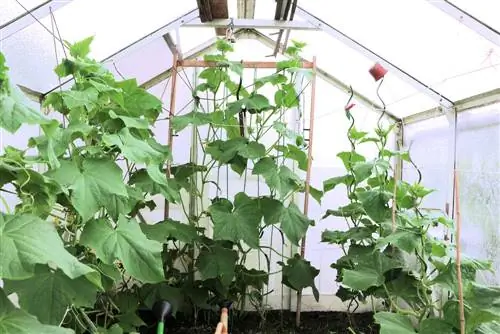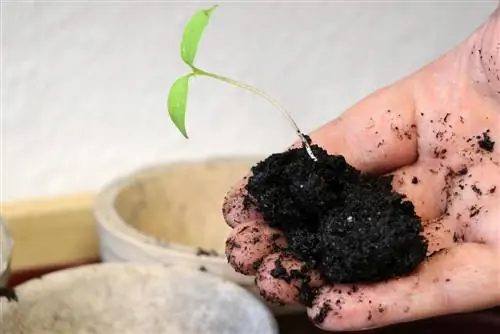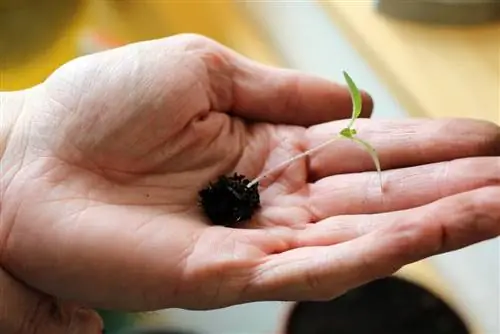- Author admin [email protected].
- Public 2023-12-17 03:39.
- Last modified 2025-06-01 06:48.
Tomatoes are quite sensitive vegetables and react quickly to stressors such as fluctuating temperatures, uneven humidity or wind with curled leaves and short growth. Even the flowers can be dropped if the plant is not feeling well. If the summer is rainy, the dreaded late blight can appear from the end of June and destroy the harvest. But all of these problems can be prevented by cultivating tomatoes in a greenhouse or foil house, because optimal growth and ripening conditions can be created here.
Which greenhouses are suitable for tomatoes?
Many varieties of tomatoes suitable for greenhouses tend to grow higher rather than wide, which is why a ridge height of at least six feet is generally recommended. A conventional tomato greenhouse is also one meter wide and offers enough space not only for the tomatoes, but also for the protected cultivation of peppers, eggplants and cucumbers. In a greenhouse there should also be enough space for tables and shelves on which the accessories can be stored - for example growing trays and pots, but also garden tools, fertilizers, etc. Furthermore, laying a water connection makes a lot of sense, because tomatoes need it right now a lot of water on hot summer days - and you certainly don't want to carry buckets of that to the greenhouse every day.
Conventional greenhouses
Greenhouses usually consist of a basic structure, the side walls and roof of which are covered with glass, plastic or foil. The framework can be made of aluminum, although this metal does not have any insulating properties and should therefore be additionally covered with plastic. Impregnated wood is also very suitable, although this can weather and therefore require a new building after a few years. Free-standing greenhouses in the garden offer the advantage that they are well lit from all sides and the light-hungry tomato plants get enough sun. Of course, you also have to set up the greenhouse in an appropriately bright location in the garden. So-called lean-to houses, which are mounted on a house wall, benefit from the heat radiation of the house wall and can be used like a winter garden if necessary.
Tip:
When building the greenhouse, don't forget the sun protection, which can be pulled in front of the roof and/or the side walls in the event of very intense sunlight (for example during the midday hours of summer). During the ripening phase, the plants should not be exposed to temperatures above 30 °C; the summer midday sun can also cause burns to leaves and fruits.
Film greenhouse
A simple foil greenhouse is much cheaper than a classic greenhouse with a brick foundation and aluminum or wooden frame. Film greenhouses often have a round or pointed arch shape and are covered with UV-stabilized, strong film. Basically, these models resemble large polytunnels like those found in strawberry fields. Higher-quality film greenhouses with a solid tubular steel construction and usually with polyethylene film as a cover, on the other hand, look more like “real” greenhouses and some even have ventilation windows. The load-bearing pipes can be anchored in the ground or embedded in concrete with foundations. However, foils cannot keep up with the thermal insulation of good double-skin sheets, and they also have to be replaced every four to eight years.
Tip:
If the film greenhouse you have selected does not have ventilation windows, ventilation must take place through the doors. Of course, these have to be correspondingly large. Alternatively, foil houses with hinged front and back sides are also available.
Useful accessories for the greenhouse
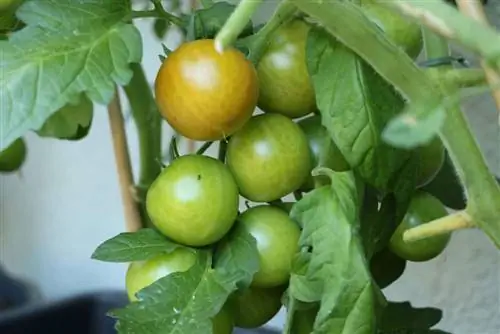
There are all kinds of helpful and useful accessories that can make your work in the greenhouse much easier. For example,
- Greenhouse tables and shelves
- automatic window openers (for automatic ventilation)
- Shade mats and nets for sunny summer days
- insulating bubble wrap for cold winters
- greenhouse-compatible fans
- special plant and propagation lamps
- Solar heat storage
- Minimum-maximum thermometer
- Heaters approved for greenhouses (e.g. circulating air and propane gas heaters, fan heaters)
Which accessories are actually useful for you and which ones are pointless depends primarily on you - and on how intensively you want to use the greenhouse. If it's just a matter of cultivating a few tomato plants in a small polytunnel, you can save yourself a lot of the tools mentioned above.
A greenhouse for the balcony
By the way, greenhouses can't just be in the garden, balcony owners can also install one. Many film greenhouses suitable for balconies are available commercially, which are sometimes also referred to as “tomato greenhouses”. Such a balcony greenhouse does not have to be particularly wide, just at least two meters high. This is especially true if you want to grow stick tomatoes. These grow less in width and instead in height. In contrast, bush and wild tomatoes require less space in height than in width - they can sometimes become quite sprawling. Anyone who owns a loggia (i.e. a balcony with glazing) instead of a normal balcony can consider themselves lucky. The glazing replaces the greenhouse and provides the tomatoes with ideal growing conditions.
Which cover is better, glass or plastic?
Traditionally, glass panes are used for the translucent cladding of cold frames and greenhouses. However, these have serious disadvantages: glass can break and it only offers poor thermal insulation. Effective insulating glass, on the other hand, is very heavy and also quite expensive. That's why double-wall or hollow-wall panels made of polycarbonate or acrylic have been on the rise for a long time. With a thickness of just four to five millimeters, they have an insulating effect due to the air trapped in them. Panels with a thickness of 16 millimeters or more offer very effective thermal insulation. Good double wall panels for outdoor use are also UV light-resistant, weatherproof and hailproof. Some manufacturers also advertise special coatings that are intended to prevent condensation or the windows from tarnishing.
How to build a simple tomato greenhouse yourself
If you are a little handy, you can build a simple tomato greenhouse yourself.
You will need the following materials:
- various squared timbers
- 3 pieces with dimensions 230x10x10 cm
- 3 pieces with dimensions 210x10x10 cm
- 2 pieces with dimensions 200x10x10 cm
- 6 roof battens with dimensions 100x10x5 cm
- 2 wooden slats with dimensions 90x2x2 cm
- Wood stain for impregnation
- Greenhouse film
And this is how the greenhouse is built:
First impregnate all wooden components to make them more weather-resistant. Now measure the rectangular floor plan measuring 200 x 80 centimeters on the selected garden area. Dig holes 50 centimeters deep at the corners and in the middle of the two long sides in which you firmly anchor the six longer squared timbers. Therefore, the timbers in one row should be lower so that the roof slopes slightly later. This allows the rain to drain away better and does not collect on the greenhouse roof. Now screw the 200 centimeter long squared timbers and the roof battens vertically so that a stable basic framework is created. Finally, attach the greenhouse film that has been cut to size using staples. The tighter the film is, the more durable the entire greenhouse is.
Tip:
The one narrow side of the self-built foil greenhouse is not closed. Instead, let the film fall loosely and simply attach it with the help of cords and straps or, if necessary, roll it up like a window blind.
Suitable tomato varieties for growing in the greenhouse

There is an almost unmanageable variety of varieties - not least because old and unusual varieties are increasingly being offered. This we alth of varieties can be divided into different groups and growth forms. These tomatoes are particularly suitable for keeping in greenhouses:
Stick tomatoes:
- will be approx. 120 to 180 centimeters
- have few branches
- develop large fruits
- recommended varieties: 'Black Ethiopan' (old, dark purple variety), 'Diplom', 'Goldene Queen' (yellow), 'Maestria', 'Phantasia', 'Tigerella' (old, red-yellow striped variety), 'Vitella'
Beef tomatoes:
- Grows like stick tomatoes
- ribbed, often very large fruits
- recommended varieties: 'Belriccio', 'Corazon', 'Delizia', 'Ruby Gold' (old, red-yellow striped variety)
Cocktail, cherry or cherry tomatoes:
- Mostly grows like stick tomatoes
- Fruits are small, often sweet and grow in bunches
- recommended varieties: 'Dolcevita', 'Rubin Pearl', 'Yellow Pearshaped' (yellow, pear-shaped)
Climbing and tree tomatoes:
- very tall stick tomatoes
- very robust against late blight and brown rot
- recommended varieties: 'De Berrao' (up to three meters high), 'Himmelssümmerer' (up to five meters high)
Currant and wild tomatoes:
- multi-shooting, some over 200 centimeters high
- strong growth
- small, numerous fruits
- often quite resistant to late blight and brown blight
- recommended varieties: 'Golden Currant' (yellow), 'Red Marble', 'Red Spoon'
Suitable substrate and compost
- Properly prepare the greenhouse floor -
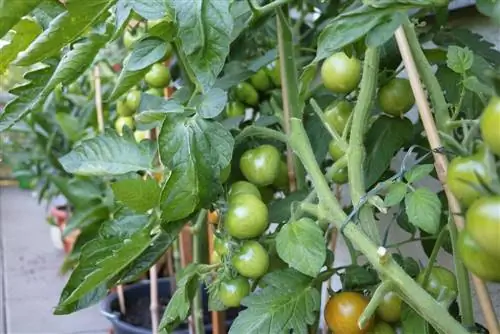
Now that the greenhouse is in place and the tomatoes have been successfully grown in the house, you can start the preparatory work from around mid to late March. In order for the plants to grow well and bear plenty of fruit, the substrate must be rich in nutrients, loose and well-drained - tomatoes are both deep-rooters and heavy feeders and benefit most from a humus-loamy soil. If this is not available in your area, dig up the tomato beds in the greenhouse to a depth of around 50 centimeters and instead fill in good topsoil with plenty of compost mixed in. If your garden soil meets the high demands of tomatoes, all you have to do is dig it up well and add plenty of compost. Also add horn shavings, potash magnesia and, if necessary, rock dust. Then crumble the thicker chunks of earth and level the beds well. The soil should now be well loosened deep down so that the plants can grow and take root easily.
How to plant tomatoes in the greenhouse
A few days before planting, it makes sense to spray the soil with your own field horsetail broth in order to counteract any fungal infections in advance. By the way, a handful of crushed nettle leaves that you add to each planting hole has the same effect. Homegrown tomatoes are ready to plant when they are around 20 to 25 centimeters high and ideally already have a few flowers. If the greenhouse is frost-free, you can plant the plants from mid-April, otherwise a month later. Please also note these instructions:
- Planting hole should be twice as large as the root ball
- Minimum distance of 60 centimeters between plants
- Bush tomatoes need more space
- sink clay pots with holes in the ground right next to the plants
- these are needed for watering
- Press tomatoes firmly and water well
You can install a cord system as a climbing aid: stretch thick cords made of natural materials vertically over the tomato beds, of which you can let another one run vertically downwards over each individual tomato plant and anchor it in the ground with a hook, for example. String tomatoes can now climb upwards on such a string.
Good neighbors - bad neighbors: Which vegetables harmonize with tomatoes
Cucumbers and tomatoes have very different requirements in terms of soil conditions, care and, above all, the climate prevailing in the greenhouse. That's why this combination doesn't work well together, especially in small greenhouses, unless you can divide the greenhouse into two climate zones and cultivate cucumbers and tomatoes strictly separately from each other. However, these types of vegetables can be combined very well with tomatoes:
- Beans (e.g. snake beans)
- garlic
- Lettuce
- Peppers
- Aubergines
- Physalis / Andean Berry
The optimal care for greenhouse tomatoes
Once the plants have finally been successfully placed in the garden house, they require careful care - only then will they grow lushly, remain he althy and produce lots of fruit.
Pouring
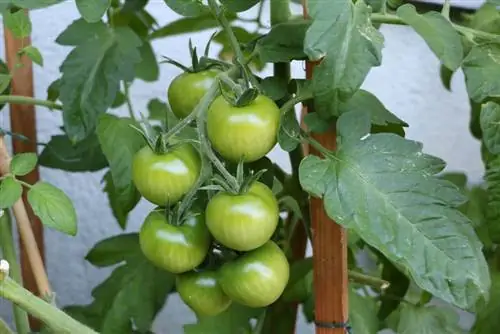
Especially during the ripening period, tomatoes need evenly moist (but by no means wet!) soil so that the fruits are not dropped prematurely or split open. Do not use cold tap water (too much lime), but rather warm rainwater for watering. Pour into the buried clay pot and avoid wetting the leaves.
Fertilize
Tomatoes are heavy feeders and not only need to be supplied with compost when planting. If the plants have grown well, you should feed them every two to three weeks with a tomato fertilizer rich in potash, preferably organic or organo-mineral based. Instead, you can also water the plants regularly with home-made broth made from nettles and comfrey.
Stripping and cutting
With stick tomatoes, you should regularly break off the side shoots that develop in the leaf axils. This is also known as stripping out and is necessary so that the plant puts its energy into the formation of flowers and fruits - and less into width growth. In addition, in mid-summer, after five or six inflorescences have developed, cut away the tip of the main shoot so that the fruits that have already formed can ripen well.
Diseases
The most common problem with tomatoes is late blight, which can occur from around the end of June. Brown, wrinkled spots form on the fruits, entire stems turn black-brown and the leaves are first grey-green, then mottled brown. If the infestation is severe, the plant dies within a short time. The disease is caused by excess moisture, which is why tomatoes should generally not be irrigated. For the same reason, good ventilation is very important in greenhouses and foil houses so that the moist air can escape outside.
Tip:
Even in the greenhouse, tomatoes should change the bed every year and, above all, should not be grown next to or after potatoes.
Harvest
Depending on the variety, the first tomatoes ripen from July onwards and can then be harvested fresh until October when the weather is mild. If the last fruits have to be harvested while they are still green, they can continue to ripen indoors in a dark and warm place. Since ripe tomatoes quickly lose their aroma in the refrigerator, it is better to store them in a cool room.
Conclusion
Tomatoes don't need as much warmth as some of their relatives, but they still thrive best in protected places or in a greenhouse. This is partly because the sensitive plants here are protected from moisture, but also because of the more uniform and, above all, warmer climate. Tomatoes should under no circumstances be irrigated as this can cause the dreaded late blight. For the same reason, the greenhouse must be ventilated regularly so that the moist air can escape outside.


